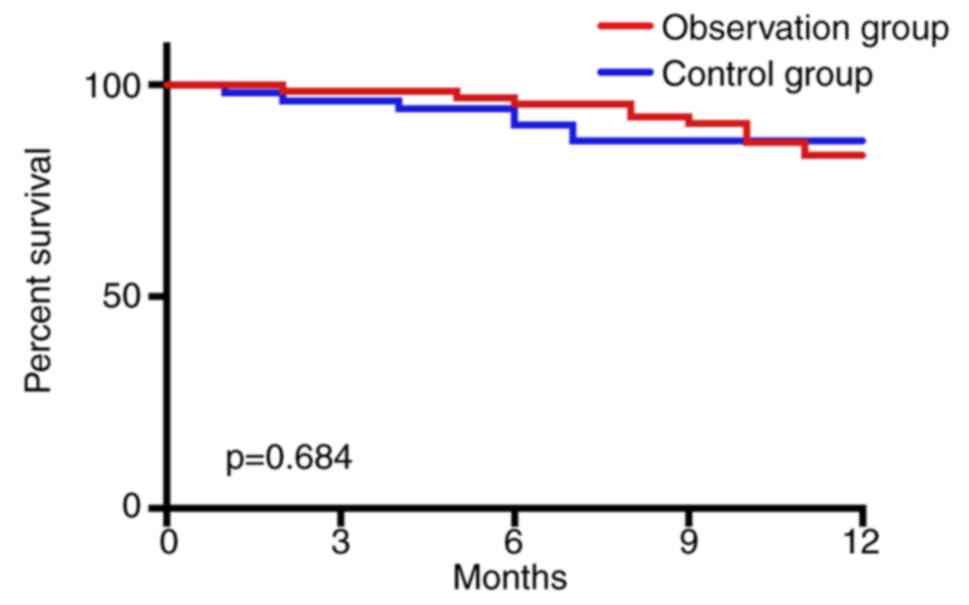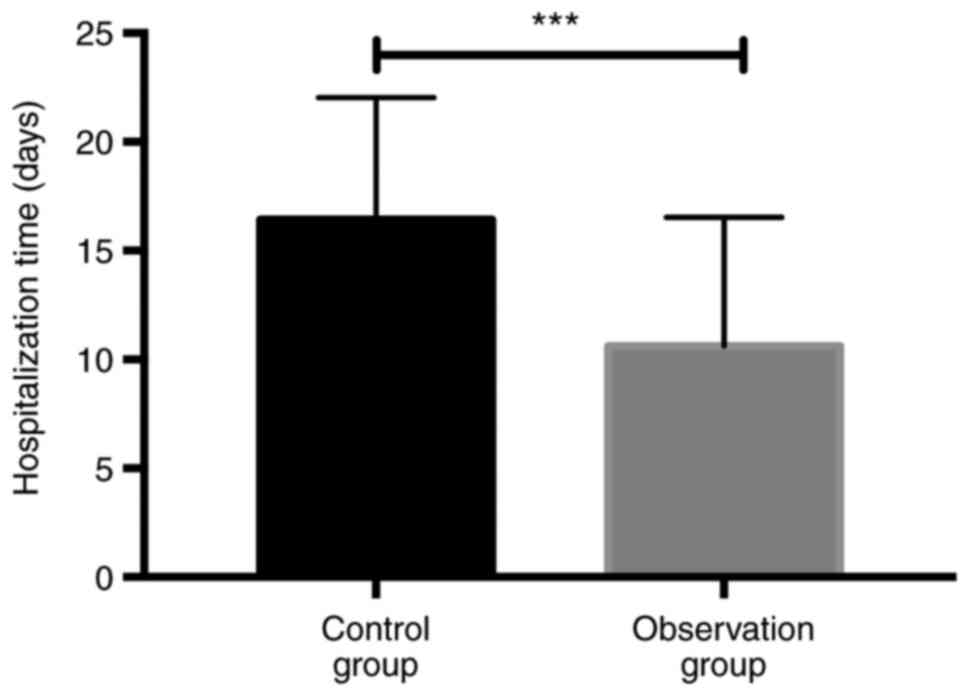|
1
|
Powers WJ: Cerebral hemodynamics in
ischemic cerebrovascular disease. Ann Neurol. 29:231–240.
1991.PubMed/NCBI View Article : Google Scholar
|
|
2
|
Singh N, Moody AR, Gladstone DJ, Leung G,
Ravikumar R, Zhan J and Maggisano R: Moderate carotid artery
stenosis: MR imaging-depicted intraplaque hemorrhage predicts risk
of cerebrovascular ischemic events in asymptomatic men. Radiology.
252:502–508. 2009.PubMed/NCBI View Article : Google Scholar
|
|
3
|
Chen PP, Lou PA, Zhang P, Qiao C, Li T and
Dong ZM: Trend analysis on the death rate of ischemic heart disease
and cerebrovascular disease among Xuzhou residents from 2011 to
2015. Zhonghua Xin Xue Guan Bing Za Zhi. 45:597–607.
2017.PubMed/NCBI View Article : Google Scholar : (In Chinese).
|
|
4
|
Li X, Zhang ZW, Wang Z, Li JQ and Chen G:
The role of argon in stroke. Med Gas Res. 8:64–66. 2018.PubMed/NCBI View Article : Google Scholar
|
|
5
|
Sviridova NK and Yavorsky VV: The
effectiveness of diagnosis and treatment of cerebrovascular
disorders in hypertensive encephalopathy in elderly patients by
studying the characteristics of cerebral hemodynamics and cerebral
perfusion status. Lik Sprava. 41–46. 2015.PubMed/NCBI(In Ukrainian).
|
|
6
|
Liu J, Liu Y, Wang L, Yin P, Liu S, You J,
Zeng X and Zhou M: The disease burden of cardiovascular and
circulatory diseases in China, 1990 and 2010. Zhonghua Yu Fang Yi
Xue Za Zhi. 49:315–320. 2015.PubMed/NCBI(In Chinese).
|
|
7
|
Zivanovic Z, Gubi M, Vlahovic D, Milicevic
M, Jovicevic M, Lucic A, Ruzicka-Kaloci S, Radovanovic B, Zikic TR,
Zarkov M, et al: Patients with acute lacunar infarction have
benefit from intravenous thrombolysis. J Stroke Cerebrovasc Dis.
28:435–440. 2019.PubMed/NCBI View Article : Google Scholar
|
|
8
|
Wu C, Wu D, Chen J, Li C and Ji X: Why not
intravenous thrombolysis in patients with recurrent stroke within 3
months? Aging Dis. 9:309–316. 2018.PubMed/NCBI View Article : Google Scholar
|
|
9
|
Fan Y, Liao X, Pan Y, Dong K and Wang Y
and Wang Y: Thrombolysis Implementation and Monitor of Acute
Ischemic Stroke in China (TIMS-China) Investigators: Intravenous
thrombolysis is safe and effective for the cryptogenic stroke in
China: Data from the thrombolysis implementation and monitor of
acute ischemic stroke in China (TIMS-China). J Stroke Cerebrovasc
Dis. 28:220–226. 2019.PubMed/NCBI View Article : Google Scholar
|
|
10
|
Wang MD, Yin XX, Yang TT, Wang Y, Zhu YY,
Zhou YF, Lu ZX and Hu B: Chinese neurologists' perspective on
intravenous thrombolysis for acute ischemic stroke. Brain Behav.
8(e00882)2017.PubMed/NCBI View
Article : Google Scholar
|
|
11
|
Mehta B, Leslie-Mazwi TM, Chandra RV,
Chaudhry ZA, Rabinov JD, Hirsch JA, Schwamm LH, Rost NS and Yoo AJ:
Assessing variability in neurointerventional practice patterns for
acute ischemic stroke. J Neurointerv Surg. 5 (Suppl 1):i52–i57.
2013.PubMed/NCBI View Article : Google Scholar
|
|
12
|
Sacks D, Baxter B, Campbell BCV, Carpenter
JS, Cognard C, Dippel D, Eesa M, Fischer U, Hausegger K, Hirsch
, et al: Multisociety consensus quality improvement revised
consensus statement for endovascular therapy of acute ischemic
stroke: From the American Association of Neurological Surgeons
(AANS), American Society of Neuroradiology (ASNR), Cardiovascular
and Interventional Radiology Society of Europe (CIRSE), Canadian
Interventional Radiology Association (CIRA), Congress of
Neurological Surgeons (CNS), European Society of Minimally Invasive
Neurological Therapy (ESMINT), European Society of Neuroradiology
(ESNR), European Stroke Organization (ESO), Society for
Cardiovascular Angiography and Interventions (SCAI), Society of
Interventional Radiology (SIR), Society of NeuroInterventional
Surgery (SNIS), and World Stroke Organization (WSO). Int J Stroke.
13:612–632. 2018.PubMed/NCBI View Article : Google Scholar
|
|
13
|
Blackham KA, Meyers PM, Abruzzo TA,
Albuquerque FC, Fiorella D, Fraser J, Frei D, Gandhi CD, Heck DV,
Hirsch JA, et al: Endovascular therapy of acute ischemic stroke:
Report of the standards of practice committee of the society of
neurointerventional surgery. J Neurointerv Surg. 4:87–93.
2012.PubMed/NCBI View Article : Google Scholar
|
|
14
|
Fischer U, Arnold M, Nedeltchev K,
Brekenfeld C, Ballinari P, Remonda L, Schroth G and Mattle HP:
NIHSS score and arteriographic findings in acute ischemic stroke.
Stroke. 36:2121–2125. 2005.PubMed/NCBI View Article : Google Scholar
|
|
15
|
Bondonno CP, Blekkenhorst LC, Prince RL,
Ivey KL, Lewis JR, Devine A, Woodman RJ, Lundberg JO, Croft KD,
Thompson PL and Hodgson JM: Association of vegetable nitrate intake
with carotid atherosclerosis and ischemic cerebrovascular disease
in older women. Stroke. 48:1724–1729. 2017.PubMed/NCBI View Article : Google Scholar
|
|
16
|
Ishida J, Konishi M, Ebner N and Springer
J: Repurposing of approved cardiovascular drugs. J Transl Med.
14(269)2016.PubMed/NCBI View Article : Google Scholar
|
|
17
|
Cheng NT and Kim AS: Intravenous
thrombolysis for acute ischemic stroke within 3 h versus between 3
and 4.5 h of symptom onset. Neurohospitalist. 5:101–109.
2015.PubMed/NCBI View Article : Google Scholar
|
|
18
|
Escudero D, Molina R, Viña L, Rodriguez P,
Marqués L, Fernandez E, Forcelledo L, Otero J, Taboada F, Vega P,
et al: Endovascular treatment and intra-arterial thrombolysis in
acute ischemic stroke. Med Intensiva. 34:370–378. 2010.PubMed/NCBI View Article : Google Scholar : (In Spanish).
|
|
19
|
Rahman WT, Griauzde J, Chaudhary N, Pandey
AS, Gemmete JJ and Chong ST: Neurovascular emergencies: Imaging
diagnosis and neurointerventional treatment. Emerg Radiol.
24:183–193. 2017.PubMed/NCBI View Article : Google Scholar
|
|
20
|
Yang Y, Liang C, Shen C, Tang H, Ma S,
Zhang Q, Gao M, Dong Q and Xu R: The effects of pharmaceutical
thrombolysis and multi-modal therapy on patients with acute
posterior circulation ischemic stroke: Results of a one center
retrospective study. Int J Surg. 39:197–201. 2017.PubMed/NCBI View Article : Google Scholar
|
|
21
|
Radnai P, Szőts M, Rádai F, Horváth G,
Varga C, Fogas J, Szörényi P, Horváth Z, Bajzik G, Moizs M, et al:
Neurointerventional treatment of acute ischemic stroke: Our
experience in kaposvar, Hungary. Ideggyogy Sz. 68:252–257.
2015.PubMed/NCBI(In Hungarian).
|
|
22
|
Loftus CM, Hoffmann M, Heetderks W, Zheng
X and Pena C: Regulation of neurological devices and
neurointerventional endovascular approaches for acute ischemic
stroke. Front Neurol. 9(320)2018.PubMed/NCBI View Article : Google Scholar
|
|
23
|
Hao Y, Qi Z, Ding Y, Yu X, Pang L and Zhao
T: Effect of interventional therapy on IL-1β, IL-6, and
neutrophil-lymphocyte ratio (NLR) levels and outcomes in patients
with ischemic cerebrovascular disease. Med Sci Monit. 25:610–617.
2019.PubMed/NCBI View Article : Google Scholar
|
|
24
|
Coutinho JM, Liebeskind DS, Slater LA,
Nogueira RG, Clark W, Dávalos A, Bonafé A, Jahan R, Fischer U,
Gralla J, et al: Combined intravenous thrombolysis and thrombectomy
vs thrombectomy alone for acute ischemic stroke: A pooled analysis
of the SWIFT and STAR studies. JAMA Neurol. 74:268–274.
2017.PubMed/NCBI View Article : Google Scholar
|
















